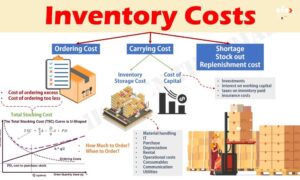Financial management is the backbone of a successful online business, yet, many entrepreneurs struggle to navigate the complex landscape of cash flow, inventory management, and profit optimization, leaving them vulnerable to financial pitfalls and missed opportunities. As the e-commerce landscape continues to evolve, the ability to effectively manage finances is no longer a nice-to-have, but a must-have for businesses that want to stay ahead of the competition. In this comprehensive guide, we’ll delve into the strategies and techniques that will help you master financial management, maximize your profits, and propel your e-commerce business towards long-term success. From cash flow forecasting to inventory optimization, and from budgeting to financial analysis, we’ll cover everything you need to know to turn your financial management into a competitive advantage.
Understanding cash flow: The lifeblood of your e-commerce business

E-commerce success hinges on a deep understanding of your financial health. Cash flow, the very lifeblood of your business, fuels operations, pays bills, and allows you to weather financial storms. Imagine your business like the human body; just as the body needs a steady flow of oxygen, your business thrives on a consistent inflow of cash. Without this, even the most innovative online store can struggle. Financial clarity is paramount. Meticulously tracking expenses, including inventory, production costs, and overhead, is crucial. Unchecked expenses can quickly eat away at your profit margins. Without a clear view of these metrics, you’re essentially flying blind, leaving your business vulnerable. Mastering both cash flow management and expense tracking, you gain the financial insight needed to make informed decisions, optimize resources, and navigate the e-commerce landscape towards long-term success. Here’s a breakdown of three crucial metrics to keep a close eye on:
Inventory: This refers to the raw materials, goods in progress, and finished products you have on hand. Tracking inventory levels is essential to avoid costly mistakes. Having too much stock (overstocking) ties up capital and risks products becoming outdated. Conversely, insufficient inventory (stockouts) can lead to lost sales and frustrated customers. Utilize inventory management tools to monitor stock levels, identify slow-moving products, and optimize your ordering process.
Production costs: These are the expenses directly associated with creating your products. This includes the cost of raw materials, labor, and any other expenses incurred during the manufacturing process. Understanding your production costs allows you to:
Set competitive prices: Factor in production costs when setting your product prices to ensure you’re generating healthy profit margins.
Negotiate with suppliers: Knowing your production costs empowers you to negotiate better deals with suppliers for raw materials or manufacturing services.
Identify cost reduction opportunities: Analyze your production costs to identify areas where you can potentially streamline processes or reduce expenses.
Overhead expenses: These are the ongoing costs associated with running your business, independent of production. Examples include rent, utilities, marketing costs, salaries (not directly tied to production), and insurance. While some overhead expenses may be fixed, others can be variable. Monitoring overhead expenses helps you identify areas where you can potentially cut costs or optimize spending to maximize your profit margins.
Mastering inventory management: Strategies for maximizing profit

Effective inventory management is the backbone of a successful e-commerce business. It’s the delicate balance between having enough stock to meet customer demand and avoiding overstocking, which can lead to costly storage and waste. When done correctly, inventory management can be a game-changer for your online store, freeing up capital, reducing waste, and increasing profit margins. Implementing a few key strategies, you can optimize your inventory levels, streamline your supply chain, and make data-driven decisions that drive growth. This includes implementing a just-in-time inventory system, leveraging data analytics to forecast demand, and utilizing inventory management software to automate tasks and provide real-time visibility into your stock levels.
Setting competitive pricing strategies to factor in profit margins

When it comes to setting competitive pricing strategies, e-commerce businesses must walk a delicate tightrope. On one hand, you want to price your products competitively to attract customers and stay ahead of the competition. On the other hand, you need to ensure that your prices are high enough to factor in profit margins and keep your business profitable. It’s a balancing act that requires careful consideration of several key factors, including production costs, market conditions, customer demand, and the prices of your competitors. By taking a data-driven approach to pricing, you can identify opportunities to optimize your pricing strategy and maximize your profits. This might involve conducting market research to determine the optimal price points for your products, analyzing customer behavior to identify price sensitivity, and using pricing analytics tools to stay ahead of the competition.
Budgeting for success: Creating a financial plan that works

Creating a financial plan is a crucial step in achieving e-commerce success. A well-crafted budget is the backbone of any thriving online business, providing a roadmap for financial decision-making and ensuring that every dollar is working towards your goals. A good budget is not just about cutting costs, but about allocating resources wisely to drive growth, increase revenue, and maximize profitability. Setting clear financial objectives and tracking expenses, you’ll be able to identify areas of inefficiency, optimize operations, and make informed decisions about investments and resource allocation. A solid financial plan will also help you navigate the inevitable ups and downs of the e-commerce landscape, providing a safety net during times of uncertainty and a platform for scaling up during periods of rapid growth.
Financial analysis: Uncovering insights to drive growth
Delving into the world of financial analysis is like uncovering a treasure trove of insights that can propel your e-commerce business towards unprecedented growth. It’s a crucial step in mastering financial management, where you scrutinize every aspect of your business’s financial performance to identify areas of improvement. By pouring over your financial statements, you’ll uncover the hidden patterns and trends that shape your business’s trajectory. You’ll discover which products are driving revenue, where costs are spiraling out of control, and which marketing channels are yielding the highest returns. With each new insight, you’ll be empowered to make data-driven decisions that optimize your operations, streamline your supply chain, and refine your pricing strategy. As you dig deeper, you’ll uncover opportunities to boost profitability, reduce waste, and fuel sustainable growth.
Understanding basic accounting principles for your business
Numbers can seem like a foreign language to some business owners, but understanding basic accounting principles is like having a secret decoder ring for your financial health! It empowers you to make informed decisions, track progress, and ultimately achieve long-term success. Here’s a breakdown of some key accounting concepts to get you started:
The accounting equation: This fundamental equation acts as the foundation for understanding your finances. It states that Assets = Liabilities + Owner’s Equity. In simpler terms, what you own (assets) is financed by what you owe (liabilities) and the money you’ve invested (owner’s equity).
The three core financial statements: These statements provide a comprehensive picture of your financial health:
Balance sheet: This is a snapshot of your financial position at a specific point in time. It lists your assets (what you own), liabilities (what you owe), and owner’s equity (the difference between the two).
Income statement: This statement tracks your revenue and expenses over a specific period, showing your profitability. It reveals how much money your business brought in (revenue) and how much it spent (expenses) to generate that income.
Cash flow statement: This statement focuses on the movement of cash in and out of your business. It helps you understand how you’re generating and spending cash, which is crucial for managing day-to-day operations.
Golden Rules of Accounting:
Double-entry bookkeeping: Every financial transaction has two sides: a debit (where the money goes out) and a credit (where the money comes in). This ensures your books are always balanced.
Accrual vs. cash basis accounting: Accrual accounting recognizes income when earned and expenses when incurred, regardless of cash flow. Cash basis accounting records income and expenses only when cash is received or paid. Choose the method that best suits your business needs.
Benefits of understanding this concepts:
Informed decision-making: By analyzing financial statements, you can make informed decisions about pricing, inventory management, and resource allocation.
Improved financial management: Track your progress towards financial goals, identify areas for improvement, and proactively address potential issues.
Secure funding: When seeking loans or investments, a strong understanding of your financials will impress lenders and potential investors.
Peace of mind: Knowing your business is financially healthy allows you to focus on growth and innovation with greater confidence.
Conclusion
As you embark on your e-commerce journey, it’s essential to remember that financial management is the backbone of your online business. By mastering the art of cash flow management, budgeting, and forecasting, you’ll be equipped to navigate the ups and downs of the e-commerce landscape with confidence. With the right financial strategies in place, you’ll be able to make informed decisions, optimize your operations, and drive growth and profitability. Don’t let financial mismanagement hold you back from achieving your e-commerce goals. So, take control of your finances today and start building a prosperous e-commerce empire that will last for years to come.

